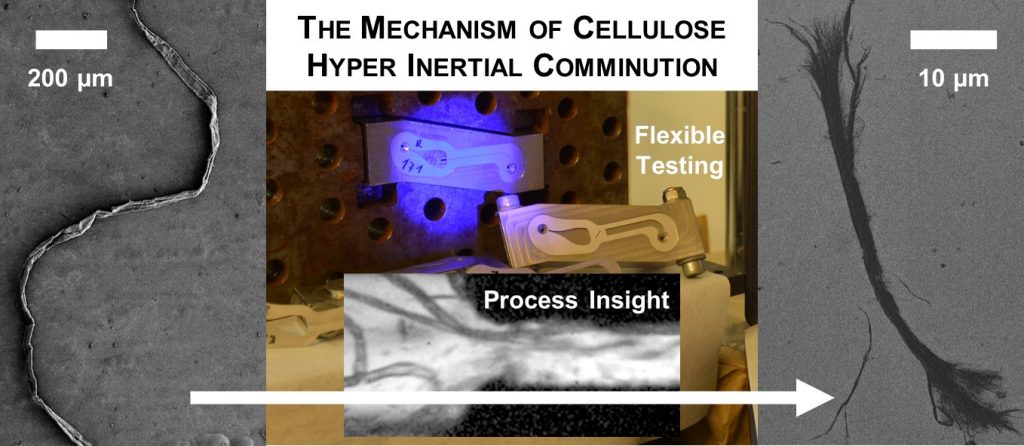Cellulose proton selective membrane “Cellfion”
Design and characterization of nanocellulose membranes to promote proton transport and selectivity for hydrogen fuel cells.
Structural characterization of cellulose and wood using electron microscopy and elecron diffraction
Cellulose is an essential constituent in the architecture of plants, where it contributes with extraordinary properties in terms of strength and stiffness. The aim of this project is to enable the development of new materials based on wood and cellulose, through the generation of new understanding regarding its structure all the way from the meso-scale […]
Mass transfer challenges in wood decomposition
Cellulose is the most abundant biopolymer. It can be extracted from the primary cell wall of green plants. The primary resource for production of cellulose is wood, where it is attached to other biopolymers such as hemicelluloses and Lignin. A challenging step in material biorefinery is separation of Lignin from cellulose, in which mass transport […]
Low density and wet stable networks of cellulose nanofibrils with a tailored 3D shape for advanced applications
The project has the following purpose and aims: (a) Novel wet-stable, low density networks of cellulose nanofibrils (CNF) with a tailored 3D structure; (b) Tailored structures through controlled freeze-linking of the CNF followed by a formation of interpenetrated polymeric networks inside the cellulose network for controlled liquid spreading and liquid holding capacity; (c) Tailored 3D […]
Surface characterization of polymeric composites and their interaction with biological tissue
This project is dedicated to understanding the properties of polymeric networks and composites thereof. Cellulose nanofibres and other fillers are included in polymeric matrices to enhance specific properties such as adhesive, mechanical or biological. The final goal is to generate next generation tissue adhesives in which bio-based materials are used to a larger extend. The […]
Hyper Inertia Micro-Fluidization (HIMF)

Hyper Inertia Micro-Fluidization is a fibre fibrillation process design platform that shifts process understanding into the focus for process design. The goal of HIMF is to capture leading mechanism in fibre fibrillation and destruction by in-situ observation and characterization of treated fibres. An essential element of HIMF is the modular design that allows for a […]
Unbleached Kraft fibers for CNF and thermoplastic biocomposites
Unbleached Kraft fibers have been used to prepare lignin-containing CNF with interesting characteristics. The fibers and fibrils will be used in thermoplastic biocomposites, and structure-property relationships will be investigated.
New functional materials based on polysaccharides
The project is on preparing novel types of polysaccharide based materials with new functionalities. The focus is on building materials with unique structures, understanding the on structure-property relationship, and then modifying the structures in a controlled way so that the materials can be utilized in a specific application.
Macro- and microscopic deformability of fiber networks made from softwood fibres
Holmen is a major Swedish producer of paper and board products. Most of these products are based on softwood fibres. During converting of the products, they are plastically deformed in folding, creasing or embossing operations. This deformation occurs both in a macro and microscale. It is therefore important to understand the influence of the raw […]
Cavitation Fibrillation of Cellulose Fibres (CaFiCeFi)

The project is of explorative nature and aims on mapping the destructive nature of cavitation on cellulose fibres. Neither cavitation nor the dispersion of cellulose fibres in its constituents (cellulose fibrils for dissolving pulp fibres) is fully understood. The project objective is to guide whether cavitation is a mean for efficient and dedicated fibrillation at […]
Flow assisted assembly of biocomposite filaments based on Cellulose Nanofibrills (CNF)
The fundamental facet of this project is to design and fabricate functional composite filaments based on CNF and polymers. The aim is to prepare filaments with superior mechanical properties and/or advanced functions. In this project, we are going to control the interaction between individual CNFs during flow assisted assembly using different heterofunctional polymers. The project is […]
Multiscale carbonized lignin nanomaterials with tailored structure for high electrochemical capacitance
The project work focuses on the development of functional nanostructured carbon material with large specific surface area and derived from sustainable materials, mainly lignin. Approaches such as electrospinning, freeze-casting as well as 3D printing can be involved. The possible applications of the carbon material can be electrodes in high-performance energy storage devices, for example, supercapacitors.

